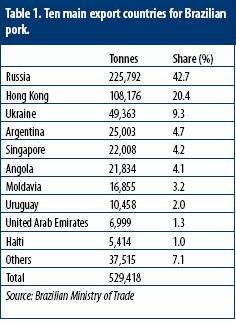Brazil: Tough year expected

2009 is proving to be an extremely difficult year for Brazil’s pork industry. The country faces increased competition from beef and chicken domestically, and is struggling to find new export markets. A roundup of 2008-2009.
By Patrick Knight
The situation for pork producers in Brazil has clearly not improved over the last year, due to the economic crisis. Just like prices for beef and poultry, prices of pork on the Brazilian domestic market have fallen by about 20% since the financial crisis peaked in November – considerably more than the percentage by which costs have fallen. Therefore, stocks of all these meats have built up strongly, as exports have fallen.
Direct results of this can clearly be felt, especially in Brazil’s pig production this year. The pork cycle is long and animals must be sent for slaughter when they are mature. That is why reports are already coming in of farmers sending more sows to market than usual, and many are abandoning the activity altogether (especially in the south of Brazil), as independent producers are forced to sell animals at less than it costs to produce them.
As for purchasing power, the financial turbulence of the last six months seems to have affected Brazil far less severely than the United States and the developed countries in Europe. Most analysts therefore suggest that spending on food in Brazil will not be affected at all by the crisis. Whether pork will be able to maintain, or increase its market share in 2009, in the light of lower prices of both beef and chicken, remains to be seen.
This all happens in the light of a continuous steady shift of pig activity to the Centre West. This is largely because the maize and soya, forming 80% of the cost of producing pigs, is grown up to 1,500 km from ports. In the west, these feed ingredients cost about 20% less than in the south. Land and water also cost far less in the west than in the main producing states, while in an area where few animals are raised, waste can be a source of income rather than a cost. Leading integrated meat companies have built large scale processing plants in the centre west region and many more are planned. As a result, the herd in the centre west has increased from 2.5 to 4.0 million head in the past ten years.
Exports
In 2008, as well as in the years prior to that, the main export market for Brazilian pork was Russia. On average, Russia imported over 20,000 tonnes monthly in the first ten months of 2008. In November, December and January 2009, the country bought just over half these amounts per month.
Exports from Brazil to Russia have been strong for the last couple of years. This happened despite a very small quota for pork and poultry, allocated to Brazil by the Russians, about four years ago. Large quotas went to the US and the European Union (EU), but since neither the US nor the EU countries managed to fill their quotas, Brazil came to dominate exports to Russia. So far, it is unclear how this situation will develop. This lack of clarity indicates the vulnerability of Brazilian pork exports – its dependence on one country. Apart from Russia, there are now only two really important markets for Brazilian pork. Last year, Hong Kong bought 108,200 tonnes (20.4%), and Ukraine bought 49,300 tonnes (9.3%), see also Table 1.
New destinations
Despite all the gloomy reports, chances of new success abroad in 2009 seem reasonable. The Brazilian currency, the real, has fallen by more than 30% against the US dollar in the past few months to the lowest level since October 2007. Lower prices will make Brazilian pork much more competitive.
The president of the Association of Brazilian Pork Exporters, Abipecs, Pedro Camargo, also voices his expectations for 2009. In his view, the EU, Japan and possibly the United States, will begin importing Brazilian pork this year. Camargo hopes that China will be added to that list, eventually importing up to 200,000 tonnes of pork. This will be in addition to the almost 100,000 tonnes sold to Hong Kong. Last but not least, shipments to Chile have recently resumed, after a gap of three years. Chile was previously one of the leading six importers of Brazilian pork and the Brazilians hope that up to 25,000 tonnes will be sold there this year.











